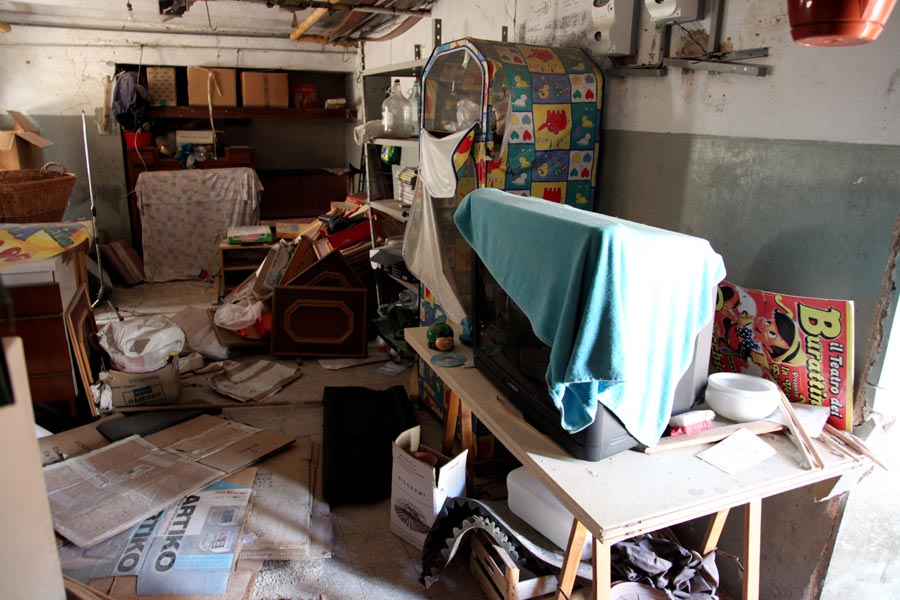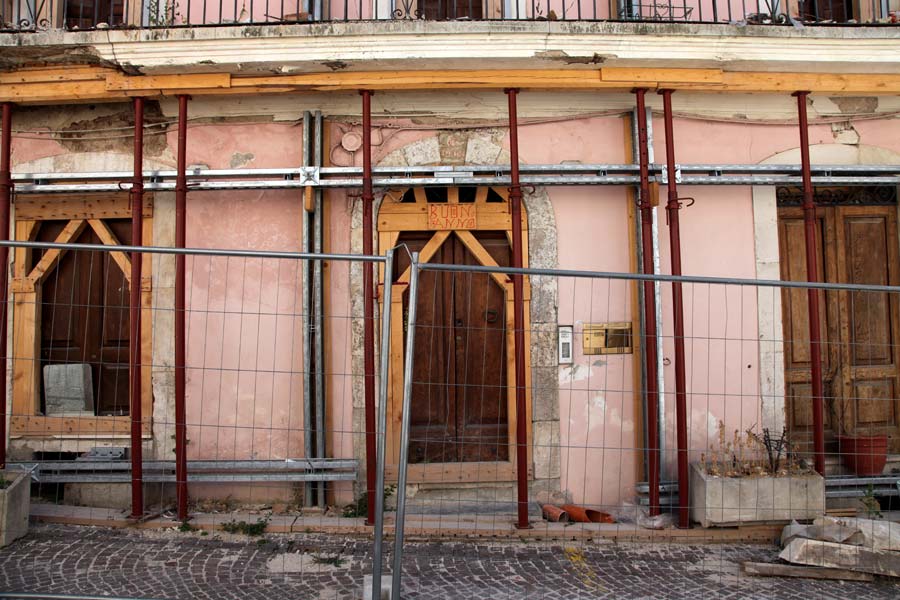08/09
Step into the red zone of L'Aquila
Washing blows in the wind long since dried, a child’s toy lies abandoned in a pile of rubble, an entire bathroom hangs at an impossible angle from a decimated apartment block. On every street corner are the haunting signs of a city abandoned in minutes, as people fled their houses in the small hours of the morning.
On April 6th, 2009 the historical city of L’Aquila in central Italy suffered a massive 6.3 m earthquake. 308 people died and over 65,000 people were forced to decamp to temporary tented cities, coastal resorts and even empty trains, in what was to become one of Italy’s most catastrophic natural disasters in recent times.
With the help of Dr Gerald Roberts from Birkbeck, University of London, and Eutizio Vittori from the Geological Survey of Italy, the Fault Line Living team were able to gain access into the ‘red zone’ – a forbidden area in the center of the city still completely abandoned a year and half since the earthquake.
Walking around the red zone, it’s hard to picture the city in all its former glory. Once charming piazzas now resemble building sites with piles of masonry stacked high. Rows of portaloos line the streets. Beautiful medieval houses are propped up with complex scaffolding and wooden beams. A stunning 13th century church, riddled with cracks and holes defies all odds to remain upright.
Most striking of all however, is the fact that these buildings were, and still are people’s homes. People have planned to carry out their lives here, and now, whilst these people aren’t technically homeless, they are demanding their homes back. Here lies the difference between a house and a home. People have been rehoused but they want their homes back.
Eutizio helped us understand the broader context around the issue of restoration, L’Aquila being one of the many towns close to fault lines in Italy:
“The restoration of L’Aquila requires a lot of money but this is the same for many towns in Central and Southern Italy. Why to intervene in L’Aquila or Naples or in other towns in Sicily and so on? Where to start? But we have to start. We have to take action. We still haven’t taken direct action here. We are still lagging behind and we have to be faster because an earthquake can arrive at any moment.”
With an estimated 11,000 buildings needing reconstruction, the question quickly becomes what is the future for such a place? Fearing their city might become a latter-day Pompeii, the locals have staged numerous sit-ins and vigils to galvanise the government into taking action. Certainly from an outsider’s perspective the sheer scale of the restoration effort seems insurmountable, but there was precious hope from Eutizio:
“The future for L’Aquila in one sense is certain. I am completely positive that this town will be rebuilt and restored as it was before. I am sure of this because the people of L’Aquila deserve this. I don’t think they will give up. But to say when this will happen is difficult. Action has been taken, work is going on, but the real job of the restoration is what people want. If other problems in the country arrive, then maybe L’Aquila will remain behind, but I am sure it will happen in the end. L’Aquila will again be the beautiful historical town it was before the earthquake”
To step inside the red zone and hear interviews with Dr Gerald Roberts and Eutizio Vittori, watch this short film:
Special thanks to:
Dr Gerald Roberts who has spent 15 years studying the fault lines in Abruzzo and is a reader in earthquake geology at Birkbeck, University of London.
Eutizio Vittori works at the Natural Hazards Unit of the Geological Survey of Italy.
Extended thanks to:
Giancanio Sileo – Università degli Studi dell’Insubria – Sede di Como, Facoltà di Scienze
Alberto Pizzi – Dipartimento di Scienze della Terra
Università “G. d’Annunzio” Chieti
Campus Universitario
Stefano Pucci – Istituto Nazionale di Geofisica e Vulcanologia Sismologia e Tettonofisica
Joanna Faure Walker – Research School of Earth Sciences, Birkbeck/UCL, University of London,
Max Wilkinson – Department of Earth Sciences, Durham University
Ken McCaffrey – Department of Earth Sciences, Durham University
Richard J. Phillips – Institute of Geophysics and Tectonics, School of Earth and Environment, University of Leeds
Alessandro M. Michetti – Università degli Studi dell’Insubria – Sede di Como, Facoltà di Scienze
Luca Guerrieri – Geological Survey of Italy, ISPRA – High Institute for the Environmental Protection and Research
Anna Maria Blumetti – Geological Survey of Italy, ISPRA – High Institute for the Environmental Protection and Research
Patience Cowie – Institute of Geography, School of GeoSciences, University of Edinburgh
Peter Sammonds – Research School of Earth Sciences, Birkbeck/UCL, University of London,
Paolo Galli – Dipartimento della Protezione Civile Nazionale, Rome
Paolo Boncio – Dipartimento di Scienze della Terra
Università “G. d’Annunzio” Chieti
Campus Universitario
Richard Walters – COMET, Department of Earth Sciences, University of Oxford


 Share
Share






11 Responses to “Step into the red zone of L’Aquila”
Colin on 16/09/2010 at 8:42 am said :
Great documentary guys, very sad though 🙁
Mark on 17/09/2010 at 6:46 am said :
brilliant pictures brings it all home
Themes : : After the shaking has stopped… – iPhone iPod iPad on 19/09/2010 at 7:39 pm said :
[…] several times before. The crew have moved from Iceland down into Italy, and recently posted an excellent movie and set of images on their WEBSITE from within the red zone of […]
Makarska on 1/10/2010 at 11:11 pm said :
This is such a deep blog! What can I say, youve hit the nail right on the head! You even added some videos to make it seem so much more real. Youve got a great way of communicating with the reader, a great way of making me feel like what you have to say is just as important to me as it is to you. Keep it up!
mel on 12/10/2010 at 9:54 am said :
makes you think
windows vista aero on 5/11/2010 at 11:11 am said :
Very Interesting Information! Thank You For Thi Blog!
trike-out malware on 9/11/2010 at 1:25 pm said :
I’ve been visiting your blog for a while now and I always find a gem in your new posts. Thanks for sharing.
low carb diet sugesstions on 9/11/2010 at 4:39 pm said :
Great Post. I add this Blog to my bookmarks.
ati software uninstaller on 9/11/2010 at 7:19 pm said :
I just book marked your blog on Digg and StumbleUpon.I enjoy reading your commentaries.
liston auctioneers limerick ireland on 10/11/2010 at 11:24 am said :
I find myself coming to your blog more and more often to the point where my visits are almost daily now!
Bulk sms on 1/12/2010 at 12:23 pm said :
Thanks for the list it will be a great help.